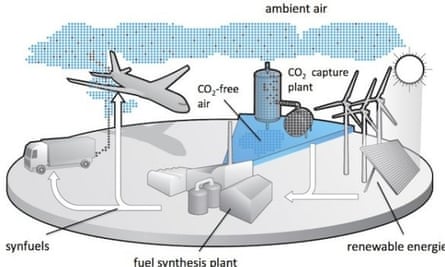The CIA was one of the funders behind yesterday’s National Research Council (NRC) reports on geoengineering, or so the rumours have it. If the intelligence community feels it is important to learn more about “climate intervention”, might not the same be true for the business community? In other words, is there money to be made here?
The NRC, the major body in the US providing scientific and technical information to policymakers, released two reports. They show two very different approaches to reducing climate change from greenhouse gases: carbon dioxide (CO2) removal and albedo modification.
Removing carbon dioxide
The gases in power plant smokestacks contain typically 10% or more CO2, whereas the atmosphere contains only 0.04% CO2. Why would anyone want to try to capture CO2 from a more dilute gas when more concentrated gases are all too readily available?
Small start-up companies, such as Carbon Engineering and Climeworks, are attempting to develop technologies that could remove carbon dioxide from the atmosphere in centralised facilities. Since the price of CO2 on available carbon markets is less than what it costs to remove CO2 from the atmosphere using these technologies, existing carbon markets are probably insufficient to drive widespread deployment. However, there is demand for carbon dioxide for use in enhanced oil recovery (EOR) operations, and many of these operations are far from suitable sources of CO2. Enhanced oil recovery operations therefore represent a possible market for these technologies.
It has even been suggested that if CO2 could be captured from air on a nuclear-powered aircraft carrier, the nuclear power could be used to split CO2 and water molecules, and the carbon and hydrogen could be combined in a chemical processing facility to produce aviation fuels. The military, therefore, is another potential market for CO2 air capture technologies.
Reflecting sunlight
Albedo modification technologies aim to cool the Earth by causing more sunlight to be reflected to outer space. With less sunlight absorbed by Earth, the planet will cool. One leading approach for doing this involves emulating the effects of large volcanoes. Large volcanoes cool the Earth by injecting large amounts of very fine particles into the stratosphere that reflect sunlight back to space, so the Earth absorbs less sunlight.
It is thought that a single fire hose constantly releasing materials into the stratosphere would be enough to offset all warming anticipated for the rest of this century. In practice, it would likely be most efficient to do this with a fleet of airplanes shuttling material up to the stratosphere. It has been estimated that the total direct cost would be about $10bn (£6.5bn) per year and require a scale of effort that would be about 1% the scale of today’s commercial aviation industry.

Since no one is likely to do this soon, and there are no existing commercial drivers of this activity, it is hard to see how to make much money from these ideas. Nevertheless, there has been some activity in this area by for-profit corporations. For example, Intellectual Ventures has applied for a patent on a balloon-based system to release materials into the stratosphere – although it is unclear whether there is a direct way for the company to profit from this patent.
Another way to reflect sunlight to space might be to brighten clouds over the ocean, for example by making a very fine mist of seawater. Armand Neukermans, who was part of the team that developed ink jet printers for Hewlett Packard, has recently produced a nozzle that can produce a fine enough spray to make the tiny particles needed to make clouds brighter. Neukermans knows a lot about nozzle design in a profit-driven environment, but his motives for developing this nozzle are, I believe, altruistic. While there is no market for brightening marine clouds, could this extraordinary nozzle technology find commercial applications in high-tech industrial processes?
Making money from climate intervention
In an economically efficient world, carbon prices would equal the damage caused by the release of an equivalent amount of carbon into the atmosphere. If carbon prices get high enough and the cost of carbon dioxide removal from the atmosphere could be made low enough, there may be potential for profit in the business of removing carbon dioxide. In contrast, it is hard to see how substantial profits can be made from global-scale albedo modification efforts. However, both of types of climate intervention research and development could potentially create important spin-off technologies. Insofar as these approaches can reduce the risk of dangerous climate change, they should affect prices in economically efficient carbon markets.
If we think society will get serious about the climate problem soon, then investing in near-zero emission energy technologies could be the winning ticket. Unfortunately, the global community is not terribly serious about reducing emissions, and much venture capital has been lost on creative new start-ups in the energy sector. The longer we take to transform our energy system so it no longer uses the sky as a waste dump, the more likely that we will have to rely on climate intervention technologies. Perhaps then there will be greater potential to profit from investments in these technologies.
The technology and innovation hub is funded by BT. All content is editorially independent except for pieces labelled “brought to you by”. Find out more here.
Join the community of sustainability professionals and experts. Become a GSB member to get more stories like this direct to your inbox.





Comments (…)
Sign in or create your Guardian account to join the discussion